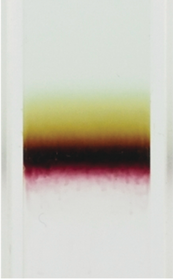The Brown Ring Test is a qualitative chemical test for the presence of Nitrate (\(\mathrm{{NO_3}^-}\)) ion in a solution. It involves the formation of an Iron (III) complex with Nitrosyl (\(\mathrm{NO}\)) as ligand, where Nitrosyl comes from the nitrate ions present in the given sample solution. This is the complex formed in the brown ring, giving it the distinct colour.

Index
Procedure for Brown Ring Test
A solution of the sample is made by dissolving a small amount of the actual sample in water (most nitrates are water-soluble). The test can then be carried out in two different ways:
- To 2mL of the sample solution, 3mL of freshly prepared saturated solution of Iron(II) sulphate is added, followed by adding 3-5mL of concentrated sulphuric acid along the sides of the test tube, such that the acid forms a layer under the mixture (the brown ring forms at the junction of the two liquids).
- To 2mL of the sample solution, 4mL of concentrated sulphuric acid is added slowly. The liquids are thoroughly mixed and then cooled under running tap water. Saturated Iron(II) sulphate solution is then slowly poured along the sides of the test tube. (the brown ring forms at the contact zone of the two liquids)
Chemistry Behind Brown Ring Test
Following are the brown ring test reactions:
$$2 \mathrm{NO}_{3}^{-}+4 \mathrm{H}_{2} \mathrm{SO}_{4}+6 \mathrm{Fe}^{2+} \rightarrow 6 \mathrm{Fe}^{3+}+2 \mathrm{NO} \uparrow+4 \mathrm{SO}_{4}^{2-}+4 \mathrm{H}_{2} \mathrm{O}$$
$$\mathrm{Fe}^{2+}+\mathrm{NO} \uparrow \rightarrow[\mathrm{Fe}(\mathrm{NO})]^{2+}$$
The first of the two above reactions is a redox reaction. Iron gets oxidized (increase in oxidation state from +2 to +3), and Nitrogen gets reduced from nitrate to nitric oxide (decrease in oxidation state from +5 to +2).
The second reaction illustrates the formation of the complex which forms the brown ring, i.e, formation of \([\mathrm{Fe}(\mathrm{NO})]^{2+}\). The Iron is generally coordinated with water (water behaves like a ligand). Hence, the complex formed in the brown ring test can also be written as :- \(\left[\mathrm{Fe}\left(\mathrm{H}_{2}\mathrm{O}\right)_{5}(\mathrm{NO})\right]^{2+}\) along with the following equation:
$${\left[\mathrm{Fe}\left(\mathrm{H}_{2} \mathrm{O}\right)_{6}\right]^{2+}+} \mathrm{NO} \rightarrow \ {\left[\mathrm{Fe}\left(\mathrm{H}_{2} \mathrm{O}\right)_{5} \mathrm{NO}\right]^{2+} + \mathrm{H}_{2} \mathrm{O} }$$
The oxidation state of Iron in the brown ring complex has been under investigation. The complex was originally reported (currently preferred) as \(\left[\mathrm{Fe}\left(\mathrm{H}_{2}\mathrm{O}\right)_{5}(\mathrm{NO})\right]^{2+}\) (Iron (I) complex with \(\mathrm{NO}^{+}\) ligand). It was later interpreted as \(\left[\mathrm{Fe}^{\mathrm{III}}\left(\mathrm{H}_{2} \mathrm{O}\right)_{5}\left({ }^{3} \mathrm{NO}^{-}\right)\right]^{2+}\) and then re-assigned as \(\left[\mathrm{Fe}^{\mathrm{II}}\left(\mathrm{H}_{2} \mathrm{O}\right)_{5}\left(\mathrm{NO}^{0}\right)\right]^{2+}\)
The complex \(\left[\mathrm{Fe}\left(\mathrm{H}_{2}\mathrm{O}\right)_{5}(\mathrm{NO})\right]^{2+}\) is said to have a pseudo-octahedral structure (i.e, the bond angles of the brown ring complex do not match with that of a regular octahedral geometry). The brown colour disappears when the mixture is shaken and heated; nitrogen oxide is evolved and a yellow solution of Iron (III) remains. The test has a sensitivity of 2.5 \(\mu g\) \(\mathrm{NO}_{3}^{-}\) and has a concentration limit of 1 in 25,000.
Limitations of Brown Ring Test
The brown ring test has a degree of unreliability, which usually happens due to the presence of other anionic radicals such as chlorate, chromate, bromide, iodide, nitrite, etc. (iodide and bromide interfere due to the halogen which is liberated).
The test is not trustworthy when cyanides, thiocyanates, hexaferrocyanate (II) and (III), iodates, thiosulphates and chromates ions (these can be removed by adding an excess of nitrate-free silver (I) solution/sodium carbonate extract, shaking vigorously for 3-4 minutes and filtering the insoluble silver salts, etc.
Other Tests for Detection of Nitrate Ions
- Test with Aluminium and Sodium Hydroxide (NaOH).
- Devarda’s Alloy Test.
- Diphenyl Amine Test.
- Brucine Test.
FAQs
The test is used for the detection of the nitrate (NO3–) nitrate anionic radical.
In the complex, Iron is in its +1 oxidation state. There is a charge transfer from NO to Iron (ligand-metal charge transfer), which gives the distinctive colour of the brown ring complex.
The Iron (II) sulphate solution must be added very carefully along the sides of the test tube. Care must be taken to not shake the test tube a lot because the brown ring complex formed is not very stable (the intensity of the colour will reduce rapidly).
